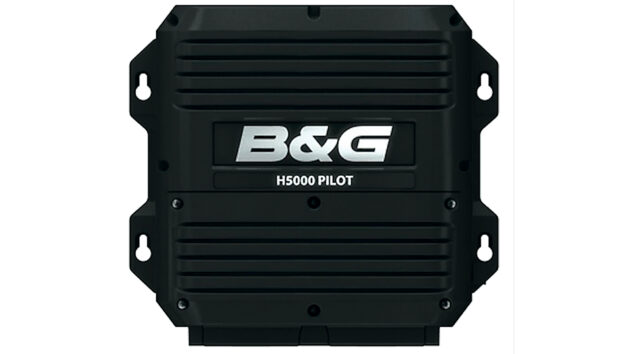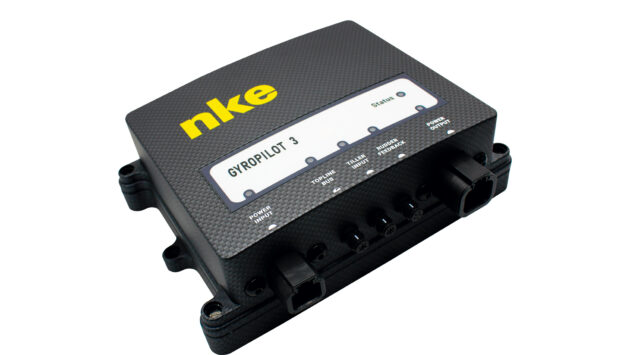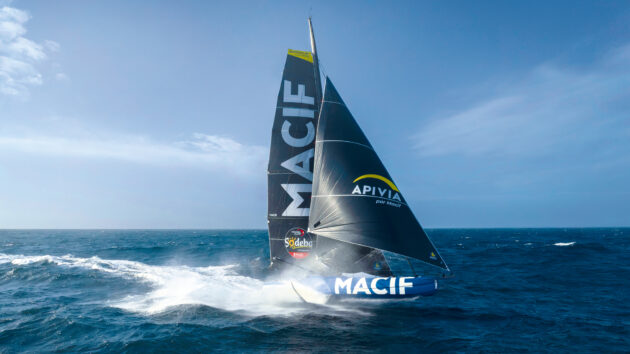Autopilot technology is evolving at a rapid pace, with the best of today’s units offering exceptional performance, both for racing and cruising. Rupert Holmes reports
It’s 0230 in the morning and we’re sailing close-hauled mid-Channel with the breeze gusting to 30 knots. In the strongest puffs our heading feathers up a little into the wind to avoid excess heel, while simultaneously maximising VMG. Equally, in the lulls we bear away a little to power the boat up and build speed.
This is exactly what you’d expect of a skilled helmsman, but I’m alone on deck, focusing on sail trim and maintaining a look out, rather than driving, while racing a Class 40 equipped with a B&G H5000 pilot system, plus additional overlays from Pixel sur Mer’s Exocet Essential system. The latter is a multifunction device that includes data logging, sophisticated sensor management and improved autopilot functionality, with both safety and performance overlays.
It’s among a number of top-level pilots that are widely recognised as offering exceptional performance. Legendary French sailor and Route du Rhum winner and record breaker, Loïck Peyron, for instance, told an audience at last year’s Yacht Racing Forum: “The new generation of pilots we have today are absolutely amazing.”
While these systems were originally developed primarily for Class 40s, IMOCA 60s and Ultime trimarans, many of the benefits they bring are equally relevant to cruising yachts, whether large high-performance catamarans or more modest monohulls. Optimising windward performance may not be a high priority for most cruisers, but a great pilot that’s properly set up will make for a more comfortable motion in challenging conditions, with less heel in gusts.
Autopilot reliability and safety
My own experience of using the Exocet Essential and B&G H5000 combination also shows it being very stable with a quartering sea, even when pushing hard with boat speeds of 20 knots, with the pilot retaining excellent control. At these speeds even a small miscalculation of the required rudder angle can create major problems, making it a challenge to develop pilots for fast boats. And of course foiling adds a whole additional dimension.
Historically, pilots were most challenged in the big waves of breezy downwind conditions, with an awkward quartering sea. This, of course, is exactly the weather in which an accidental gybe can be particularly dangerous. In last year’s Rolex Sydney Hobart race, for instance, two crew members on different boats died as the result of a head injury and crush injuries in heavy weather.
While these vessels had full race teams on board and were being hand-steered at the time, a pilot that can steer reliably in these conditions can be a big boost to the safety of a cruising yacht, even if a preventer is properly set up.
A good pilot will also create a more comfortable motion in these conditions, markedly reducing the tendency to corkscrew. However, to be safe, the system must also have bulletproof reliability. More on that later.

B&G’s H5000 Pilot has years of development expertise behind it
The Exocet’s overlays take the form of an expert system – a type of AI – that sits between the user and the H5000 controller. The B&G unit sees it as a virtual pilot controller, while the expert systems change the requested pilot heading depending on inputs from sensor data, including speed, heel and wind data.
In effect, the pilot computer sees this as the same thing as a human pressing the +/- 1 buttons a few times to help the boat, for instance, to bear away in a gust when broad reaching, even before the heel angle starts to increase. The system is close to achieving the holy grail of steering in a pro-active manner, just like a skilled human helmsman. By contrast, traditional pilots are only reactive – they must wait for a parameter to change and then react to it.
The Exocet’s overlays also allow you to sail to a heel angle, for instance when downwind or blast reaching in exactly the same way as you would sailing a planing dinghy – bearing away in the gusts and coming up in the lulls. It can also steer to a target speed, heading up as much as possible, while trying to stay within the user’s requested heel angle target range, or to a wind angle target, and two overlays can be used simultaneously.

Exocet Essential is Pixel Sur Mer’s entry level data acquisition and navigation system
This may sound complex but the reality is it’s a bit like sail trim and French short-handed racers talk about ‘trimming the pilot’ in much the same way as trimming sails. For fast cruising you can pick settings that are approximately right to achieve great performance, but extra effort in this respect can pay dividends when racing.
Before choosing a system it’s worth being ruthlessly realistic about how much set up you’re actually going to do. I’ve sailed raceboats with complex and expensive electronics that require extensive set up to get decent performance, yet every setting was still on the factory default even after the completion of a Rolex Fastnet Race campaign.
The owners of these boats might therefore have been better served by a more economic plug-and-play system, such as Raymarine’s Evolution series, that uses AI originally developed by then parent company FLIR to improve performance without the need for users to tweak complex settings.

NKE Gyropilot 3 – the French firm is popular with professional racers
Choosing systems to suit
Different manufacturers take different attitudes to the amount of set up required to gain maximum performance from a pilot. Both Raymarine and Garmin, for instance, have opted for a simple approach with automated calibration used wherever possible. Yet this doesn’t necessarily imply a dumbed-down method.
Part of the rationale behind Raymarine’s recently launched RSW SmartWind sensor, for instance, was to improve performance of its Evolution range of pilots, without the need for either a time-consuming set up or a complex user interface.
Both a nine-axis sensor and a processor are built into the SmartWind masthead unit, enabling real-time cleaning of the wind data that takes account of the boat’s roll and pitch, factors that, of course, are greatly magnified aloft. The upwash from the top of the rig is also estimated for different wind angles and strengths. The result is significantly better pilot performance, especially upwind and downwind, when you’re most likely to be using wind modes.
While this is not as accurate as comprehensive calibration achieved over a long period of time by professional race navigators, it represents a huge step forward for everyone else.
“Our aim with this was to give 85-90% of the performance of very high end systems straight out the box,” Raymarine product management director Will Sayer told me.

Raymarine keeps things simple by using a new SmartWind masthead sensor to improve performance of its Evolution range of pilots, aiming to achieve 80% of the performance of high-end systems, without the complexity
B&G’s collaboration with Pixel sur Mer also includes markedly improved course keeping algorithms for the high-end H5000 pilot system.
“The H5000 pilot needs to function across a wide range of boats, from the Sun Fast 30 through IMOCAs to superyachts, as well as more modest cruisers sailing across the Atlantic,” says B&G product director Matt Eeles. After basic calibration procedures, it therefore performs well out of the box across all these boats and for all but the most demanding of users in high echelons of the racing world.
“Working with Pixel sur Mer we were able to test changes to the B&G algorithms one at a time in a controlled environment on a very wide variety of boats, for instance to see what standard settings needed to change to improve the weather helm algorithm,” Eeles adds.
“The process took years before it could be rolled out to the public, via a software update early last year.” This improved functionality is also available to existing H5000 users.
This system therefore gives users the opportunity to use it with a minimum of set up, while also having the benefit of more advanced settings that can be tweaked to improve steering response in a wide range of more testing conditions.

The Madintec pilot system was designed from scratch to make extensive use of AI to boost performance
Features include a recovery mode that quickly corrects for sudden course deviations caused by out of pattern waves. Gust response takes preventative action based on instrument data to hold a more stable course in changeable winds. Thirdly, high-wind response bears the yacht away when wind speed increases while reaching, keeping the boat flatter and driving faster. There are also failsafe algorithms and user configurable hard limits that increase safety factors.
AI simplicity wins
Madintec, another small French company, was formed in 2017 with the express intention of creating the ultimate pilot system, creating an all-new platform from scratch that makes extensive use of AI to boost performance, streamline the user interface and improve sensor calibration.
Yet at the same time, a key principle from the outset was that it had to be simple. “Simple for pro sailors and simple for amateurs,” research engineer Pia Mathias told an audience at the Yacht Racing Forum. “If we look at the Vendée Globe, sometimes skippers haven’t eaten in a few days and they haven’t slept a lot. So a tired skipper has to be able to use our pilots and a new skipper also has to be able to use them.”
The company was founded by veterans of an America’s Cup campaign who saw an opportunity to transfer technologies and methodologies from both the Cup and the aerospace sector into offshore yacht racing and then into more everyday sailing. It has been hugely successful, with the system, for example, chosen by the last two Vendée Globe winners, Charlie Dalin and Yannick Bestaven.
While Madintec originally had Class 40s, IMOCAs and Ultimes in mind, it’s now also gaining traction among short-handed IRC racers and in the cruising world. The first four 33ft Pogo RCs, for instance, are all equipped with Madintec systems. It also worked closely with MODX to develop a fully automated control system for the inflatable wing sails on this extraordinary 70ft catamaran.
Time to hand over?
So, what about the question of whether today’s AI-enhanced performance pilots make for better helmsmen than humans?
While that’s the ultimate aim, and the very best systems are making great strides in that direction, they aren’t there yet. A lot of recent R&D has also been spent on controlling the flight of foiling boats, technology less relevant to the majority of cruising sailors. So, arguably no pilot is yet as good as a skilled and focused human driver, an important point for the crewed offshore racing world – but they can be a lot better than a less skilled and tired crew member on a cruising yacht!
 If you enjoyed this….
If you enjoyed this….
Yachting World is the world’s leading magazine for bluewater cruisers and offshore sailors. Every month we have inspirational adventures and practical features to help you realise your sailing dreams.Build your knowledge with a subscription delivered to your door. See our latest offers and save at least 30% off the cover price.
Note: We may earn a commission when you buy through links on our site, at no extra cost to you. This doesn’t affect our editorial independence.





